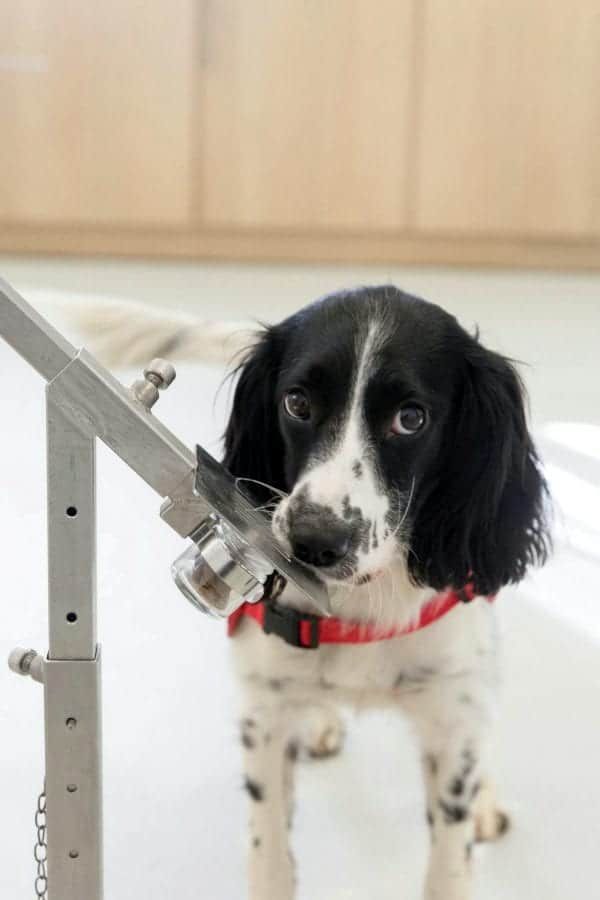
As many dog owners know, their pets love carrying round the worn and smelly sock of their owners.
Now British and African scientists have used that trait to train dogs to sniff out malaria from a child’s dirty sock.
The sock sniffing ability could be used to quickly spot those with the deadly disease before they show symptoms so they can be treated and stop the disease spreading.
It is also hoped the findings could potentially lead to the first rapid and non-invasive test for malaria with odour sensors.
But the dogs would be ideal to quickly screen large numbers of people rather than carrying out current tests on each person which involved the finger prick test to draw blood.
Principal Investigator Professor Steve Lindsay, in the Department of Biosciences, Durham University said: “People with malaria parasites generate distinct odours on their skin and our study found dogs, which have an incredibly sensitive sense of smell, can be trained to detect these odours even when it’s just on an article of clothing worn by an infected person.
“While our findings are at an early stage, in principle we have shown that dogs could be trained to detect malaria-infected people by their odour with a credible degree of accuracy.
“This could provide a non-invasive way of screening for the disease at ports of entry in a similar way to how sniffer dogs are routinely used to detect fruit and vegetables or drugs at airports.
“This could help prevent the spread of malaria to countries that have been declared malaria free and also ensure that people, many of whom might be unaware that they are infected with the malaria parasite, receive antimalarial drug treatment for the disease.”
The study used nylon socks to collect foot odour samples from apparently healthy children aged five to 14 in the Upper River Region of The Gambia in West Africa.
The children were screened for the malaria parasite Plasmodium falciparum in their blood using a simple finger-prick test.
The sock were then brought to the Medical Detection Dogs charity in Milton Keynes, where Lexi, a Labrador-Golden Retriever cross Lexi and Sally a Labrador were trained to distinguish between the scent of children infected with malaria parasites and those uninfected.
In total 175 sock samples were tested including those of all 30 malaria-positive children identified by the study and 145 uninfected children.
The dogs were able to correctly identify 70 per cent of the malaria-infected samples.
The dogs were also able to correctly identify 90 per cent of the samples without malaria parasites.
Identifying people infected with the malaria parasite, but not presenting symptoms, is critical as they can be treated with antimalarial drugs and the spread of the disease can be prevented.
Sniffer dogs could provide a non-invasive, portable and rapid test for identifying malaria carriers and would be particularly useful in settings where there are few individuals with malaria parasites.
Confirmation of the disease would then be made by taking a finger-prick sample of blood using a rapid diagnostic test.
Since the initial study Freya, a Springer Spaniel, has also been trained to detect malaria.
Study co-author Dr Claire Guest, Chief Executive Officer of Medical Detection Dogs, said it has had “positive results training dogs to detect diseases including cancer and diabetes sugar changes by odour.
“This is the first time we have trained dogs to detect a parasite infection and we are delighted by these early results.
“The possible potential to train dogs to detect tropical disease where diagnostics are poor, such as leishmaniasis and trypanosomiasis is huge.
“I believe that this study indicates that dogs have an excellent ability to detect malaria and if presented within an individual infected with the parasite or a piece of recently worn clothing, their accuracy levels will be extremely high.
“This is a reliable, non-invasive test and is extremely exciting for the future.”
The World Health Organisation said since 2000 six countries have been certified malaria free, with another 12 countries reporting that no malaria cases have originated within their borders.
But there are still an estimated 216 million cases of malaria in 2016, an increase of five million cases over the previous year and it kills 445,000.
Co-author Professor James Logan, Head of the Department of Disease Control, at the London School of Hygiene & Tropical Medicine, said: “Worryingly, our progress on the control of malaria has stalled in recent years, so we desperately need innovative new tools to help in the fight against malaria.
“Our results show that sniffer dogs could be a serious way of making diagnosis of people who don’t show any symptoms, but are still infectious, quicker and easier.”
Co-author Professor Umberto D’Alessandro, Unit Director at the Medical Research Council Unit The Gambia at the London School of Hygiene & Tropical Medicine said: “Detecting malaria-infected but otherwise healthy people is a laborious and time-consuming process that requires collecting a blood sample to be then processed in a well-equipped laboratory.
“New approaches to facilitate the identification of infected individuals to be treated would help enormously in addressing the human reservoir of infection and possibly reduce malaria transmission.
“The opportunity to use trained dogs for this purpose is promising. Results show that it may be possible to identify infected people by their body odour.”
In future artificial odour sensors might be developed to detect malaria parasites, but until then trained dogs could be a useful alternative at ports of entry.
However, they say that further research is needed to see if dogs can directly sniff out malaria in people infected with the disease and from other parts of the world.
The research was presented at the American Society of Tropical Medicine and Hygiene Annual Meeting in New Orleans.